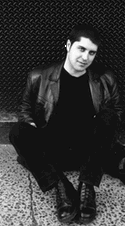
Stephen Cain currently resides in Toronto, where he is editor of Kitsch in Ink Press and a member of the (n-1) Collective. Previous chapbooks have appeared from fingerprinting inkorporated and above/ground presses. His visual and concrete poetry has appeared in Rampike, Torque, 1cent (Canada, and Essex (US). Cain is also completing a doctorate in English Literature at York University, specializing in Modern and Contemporary Poetics.
Author photo by Steve Venright. |
dyslexiconis both an online text and (soon to be) a printed book. The book version of dyslexicon will strive to mirror content and form the way this online version does. The 96 page book is spiral bound and readable in several directions.
Some of the nice things said so far about dyslexicon
"Cain has begun to distinguished himself as an important innovator who can offer a radical lexicon for a future poetry. a no(u)n by Stephen Cain is a tour de force... the kind of beautiful experiment that does not repeat the emotions of a mediocre lyricism.
Christian Bok in Word (1997).
Author's Statement on the Text
dyslexiconproposes that there exists an alternative lexicon to that of common usage. A parallel language of shadows and
mirrors which interrogate and problematize conventional
discourse.
dyslexicon, at its simplest level, is a series of verbal portraits of various subjects: compact discs, persons, places,
and things. Its impetus was initially an attempt to update
Gertrude Stein's TENDER BUTTONS to a late capitalist subjectivity
of imagery and cultural phenomena, as well as to include an
awareness of post-structural critical theory and notions of
grammatology. The project soon moved, however, to an alternative
experiment with personal subjectivity in which the poet would act
as a filter of the emotional, geographical, historical, and
cultural flux society feels as it moves towards the millennium.
"a no(u)n" is the closest to Stein's text, but rather than
exploring the domestic sphere of objects, food, and rooms, it
moves to a more active sphere of participation in which the
subjects of the portraits are other writers, locations in
Toronto, and items involved in the creative process. Each
portrait is an attempt to describe the subject in linguistic
terms without actually referring to any concrete detail of the
subject or actually naming the subject within the text.
The shadow text to "a no(u)n," "detector," works in the
opposite fashion. Here the name of each object considered for
description is contained in each sentence of the text, yet as
they function both as nouns and verbs and each sentence does not
seem to have continuity with the following, the actual sentences
do not end up describing the denominated subject.
The connection between poetry and music has often been
noted, but the role of extraneous music in the composition of
non-related texts only really came to the fore in the High
Modernist Project (a subject which this text is explicitly
engaged with in an interrogative manner). This would include
Pound's claim that poetry should be composed "in the sequence of
a musical phrase" as well as Eliot's and Woolf's use of Beethoven
in the composition of FOUR QUARTETS and THE WAVES. In "Circa
Diem" ten contemporary pop albums are considered with each
paragraph representing an individual track, and the page length
roughly approximating the length of the listening experience.
Each piece incorporates elements of the album, snatches of
lyrics, musical notation, references to the album art, and
subjective emotions and experiences to create a cubist collage of
the music at hand. In so doing it attempts to give the reader a
sense of the experience of listening to the album without
actually hearing the music.
"dix mots pour rien" presents fictional dialogues of various
historical and cultural figures who inform much of the
inspiration and structure of dyslexicon. A reversal of Pound's "ego-system" in which the poet converses with various poetic figures of the past, this text attempts to create an environment
in which the reader becomes privy to non-existent conversations
between character-functions thus making the reader a textual
voyeur.
The outstanding design of this book was conceived and executed by Bill Kennedy. Thanks Bill! |